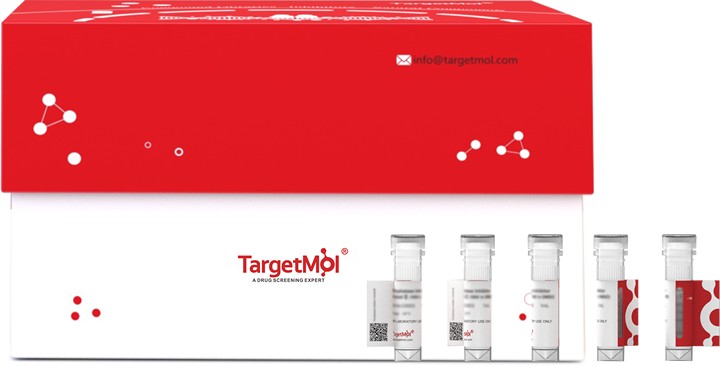- 全部删除
 您的购物车当前为空
您的购物车当前为空
B3GAT1 Protein, Human, Recombinant (His)
B3GAT1 is the key enzyme during the biosynthesis of the carbohydrate epitope HNK-1, which is present on a number of cell adhesion molecules important in neurodevelopment. It adds a glucuronic residue to the terminal lactosamine residue (Gal beta 14GlcNAc) of a glycoprotein or glycolipid, which can be further sulfated to become the HNK1 epitope, a unique trisaccharide structure, HSO3-3GlcA beta 1-3Gal beta 1-4GlcNAc. The enzyme activity was found to be enhanced in the presence of sphingomyelin and phosphatidylinositol. The HNK1 carbohydrate epitope is characteristically expressed on a series of cell adhesion molecules in addition to some glycolipids in the extracellular matrix and on the cell surface in the nervous system, where it is involved in cell-cell and cell-substratum interaction and recognition during the development of the nervous system. Like most known glycosyltransferases, B3GAT1 is a type II Golgi-resident transmembrane protein with a short N-terminal cytoplasmic domain and a single pass transmembrane domain followed by an enzymatic domain in the lumen of Golgi apparatus. The enzyme activity was assayed using a phosphatase-coupled method.

B3GAT1 Protein, Human, Recombinant (His)
| 规格 | 价格 | 库存 | 数量 |
|---|---|---|---|
| 10 μg | ¥ 750 | 5日内发货 | |
| 50 μg | ¥ 2,260 | 5日内发货 | |
| 500 μg | ¥ 12,800 | 5日内发货 | |
| 1 mg | ¥ 19,200 | 5日内发货 |
产品信息
| 生物活性 | Activity has not been tested. It is theoretically active, but we cannot guarantee it. If you require protein activity, we recommend choosing the eukaryotic expression version first. |
| 产品描述 | B3GAT1 is the key enzyme during the biosynthesis of the carbohydrate epitope HNK-1, which is present on a number of cell adhesion molecules important in neurodevelopment. It adds a glucuronic residue to the terminal lactosamine residue (Gal beta 14GlcNAc) of a glycoprotein or glycolipid, which can be further sulfated to become the HNK1 epitope, a unique trisaccharide structure, HSO3-3GlcA beta 1-3Gal beta 1-4GlcNAc. The enzyme activity was found to be enhanced in the presence of sphingomyelin and phosphatidylinositol. The HNK1 carbohydrate epitope is characteristically expressed on a series of cell adhesion molecules in addition to some glycolipids in the extracellular matrix and on the cell surface in the nervous system, where it is involved in cell-cell and cell-substratum interaction and recognition during the development of the nervous system. Like most known glycosyltransferases, B3GAT1 is a type II Golgi-resident transmembrane protein with a short N-terminal cytoplasmic domain and a single pass transmembrane domain followed by an enzymatic domain in the lumen of Golgi apparatus. The enzyme activity was assayed using a phosphatase-coupled method. |
| 种属 | Human |
| 表达系统 | HEK293 Cells |
| 标签 | N-6xHis |
| 蛋白编号 | Q9P2W7 |
| 别名 | β-1,3-glucuronyltransferase 1 (glucuronosyltransferase P),NK-1,NK1,HNK1,GlcAT-P,CD57,beta-1,3-glucuronyltransferase 1 (glucuronosyltransferase P),B3GAT1 |
| 氨基酸序列 | His25-Ile334 |
| 蛋白构建 | His25-Ile334 |
| 蛋白纯度 | Greater than 95% as determined by reducing SDS-PAGE. (QC verified)  |
| 分子量 | 50-60 KDa (reducing condition) |
| 内毒素 | < 0.1 ng/µg (1 EU/µg) as determined by LAL test. |
| 缓冲液 | Lyophilized from a solution filtered through a 0.22 μm filter, containing 20 mM Citrate, 8% Sucrose, 100 mM NaCl, 0.05% Tween 80, pH 6.0. |
| 复溶方法 | Reconstitute the lyophilized protein in distilled water. The product concentration should not be less than 100 μg/ml. Before opening, centrifuge the tube to collect powder at the bottom. After adding the reconstitution buffer, avoid vortexing or pipetting for mixing. |
| 存储 | Lyophilized powders can be stably stored for over 12 months, while liquid products can be stored for 6-12 months at -80°C. For reconstituted protein solutions, the solution can be stored at -20°C to -80°C for at least 3 months. Please avoid multiple freeze-thaw cycles and store products in aliquots. |
| 运输方式 | In general, Lyophilized powders are shipping with blue ice. Solutions are shipping with dry ice. |
| 研究背景 | B3GAT1 is the key enzyme during the biosynthesis of the carbohydrate epitope HNK-1, which is present on a number of cell adhesion molecules important in neurodevelopment. It adds a glucuronic residue to the terminal lactosamine residue (Gal beta 14GlcNAc) of a glycoprotein or glycolipid, which can be further sulfated to become the HNK1 epitope, a unique trisaccharide structure, HSO3-3GlcA beta 1-3Gal beta 1-4GlcNAc. The enzyme activity was found to be enhanced in the presence of sphingomyelin and phosphatidylinositol. The HNK1 carbohydrate epitope is characteristically expressed on a series of cell adhesion molecules in addition to some glycolipids in the extracellular matrix and on the cell surface in the nervous system, where it is involved in cell-cell and cell-substratum interaction and recognition during the development of the nervous system. Like most known glycosyltransferases, B3GAT1 is a type II Golgi-resident transmembrane protein with a short N-terminal cytoplasmic domain and a single pass transmembrane domain followed by an enzymatic domain in the lumen of Golgi apparatus. The enzyme activity was assayed using a phosphatase-coupled method. |




